Vintage Fender Guitars, Basses, Amps.
Introduction and General Specs.
Overview of collecting vintage Fender guitars, basses and amps. General specifications, serial numbers, Fender vintage guitar cases. Private vintage guitar collector.
Picture Gallery, Fender section.
Contact the vintage guitar info guy.
September 1952 Fender calendar.
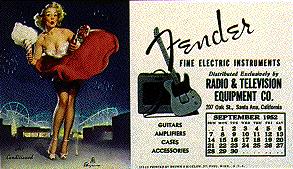
- Introduction
- Serial Number/Year Identification
- General Fender Parts & Detail Specs
- Fender Cases
- Fender Custom Colors
- Reissue and Original Fender Vintage Parts Comparison
- Models: Fender Electric Model Info
- Models: Fender Acoustic Flattop Info
- Inside a 1954 Fender Stratocaster.
- Inside a 1958 Fender Jazzmaster.
 Inside
a 1951 to 1969 Fender Telecaster video.
Inside
a 1951 to 1969 Fender Telecaster video.
 Inside
a 1954 to 1965 Fender Stratocaster video.
Inside
a 1954 to 1965 Fender Stratocaster video.
- Fender Electric Guitar Schematics
- Vintage Fender Guitar Pickup Specs
- Fender Amplifiers
DVD video version of this web page for Stratocasters and Telecasters:

Introduction.
-
For most collectors, pre-CBS (pre-1966) Fender vintage guitars and
amps are the desirable ones. Although CBS purchased Fender
(officially) on January 3rd 1965, it took some time till the guitars
changed (though by mid 1964, six months before CBS bought Fender,
things were already "on the way down").
By the end of 1965, the general look and
feel of the Fender guitars had changed significantly. All collectors feel the quality of
their instruments and amps suffered as CBS employed more "mass production"
manufacturing processes to the Fender guitars. The "large peghead" (starting
in late 1965) as used on the Fender Stratocaster was one example of the
(bad) changes to come. The "custom contoured" bodies Fender was famous
for no longer were as sculped and sleek. Newer (and less attractive) plastics
were used for the pickguards. Pearl fingerboard inlays replaced the
original "clay" dots. Indian rosewood replaced the beautifully figured
Brazilian rosewood on the fingerboards. And by 1968, polyurathane replaced
the original nitrocellulose lacquer that was used from Fender's conception.
By early 1971 the party was truely over. Fender now employed the infamous
"3 bolt neck" and one piece die cast bridge on the Strat, ruining it's
tone and feel. Many other models suffered the same miserable fate of
being over mass-produced and cheapened by corporate zealots.
Because of this, Fender's most innocent era of the 1950's is their most collectible. This decade produced guitars with one-piece maple necks, single layer pickguards, thin "spaghetti" logos, and tweed cases that seem to capture collectors the most.
The early 1960's Fenders with "slab" rosewood fingerboards are also collectible, but not to the extent of the earlier 1950's maple-neck era. Of the rosewood fingerboard models, the "slab" fingerboard (1958/mid-1959 to August 1962) variants are more desirable than the "veener" fingerboard (August 1962 and later) pre-CBS models. The "transistion" era (late summer 1964 to December 1965) are the least collectible of the pre-CBS models. This era is known as a "transition" because later summer 1964 to December 1965 was the time when there was a transition from the Leo Fender management to CBS management, and mass-production manufacturing techniques were starting to take a firm hold.
By 1966 (a year after CBS bought Fender), CBS management had really taken hold of Fender's production facilities and incorporated many changes. The sum of of all these changes had a serious effect on Fender guitars as a whole. 1966 brought an era of "large" pegheads, less contoured bodies, and much higher production numbers. CBS looked for ways to cut production time and costs, which generally led to much lower quality. Because of this, 1966 and later Fender instruments are considered far less collectible than vintage pre-CBS Fender guitars.
The Guitar Models.
-
The Esquire was Fender's first electric
spanish guitar. Originally introduced
in June of 1950 as a black (and later blond), one or two pickup model,
it was discontinued by Fender's marketing arm in September 1950.
Only about 50 of these original Esquires were shipped, though Fender
had a backorder of hundreds of units. And many came back
to Fender to have the neck (and body!) replaced because of neck warpage,
from the lack of a truss rod.
In October 1950, the Broadcaster replaced the Esquire as their two pickup
electric spanish guitar, with a truss rod! The Esquire was re-introduced in early 1951 as a
single pickup version of the Broadcaster.
The 1951 and later Esquire,
because of its single pickup, does not have the value today of its
two pickup brother, due to its limited tonal range with one pickup.
By February 1951, the Broadcaster
was renamed the Telecaster (though the
guitars didn't actually have a "Telecaster" decal on them until the summer of 1951),
because of a naming conflict with a trademarked Gretsch drum line.
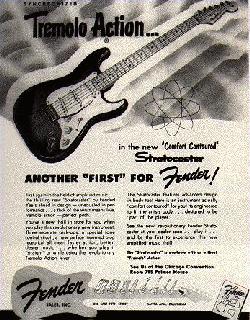
-
The Fender Stratocaster (and
Telecaster) from the 1950's put the solidbody electric guitar on the map.
The Stratocaster was like no other guitar ever produced. With three
pickups, a contoured body that made playing guitar comfortable, and
a tremolo built-in and designed correctly for the guitar, made it
an instant sucess. Even today, nearly 50 years later, the Stratocaster
is the electric guitar by which all others are judged.
From country, to rock and roll, to surf music, Fender found a niche with its instruments. Especially different for the era was those Fenders with Custom Color finishes. Hence they are more valuable than the standard finish (usually Sunburst, or Blond for the Telecaster/Esquire).
-
The Jazzmaster, introduced in
1958, became Fender's "top of the line" instrument (though today's
vintage guitar market does not hold this view; it's clearly a
3rd class citizen behind the Strat and Tele). Fender truely thought
the Jazzmaster would make a sensation in the jazz scene. Instead,
it became the main instrument of many Surf-guitar bands of the 1960's.
-
Likewise, in 1962 Fender introduced another "top of the line" instrument
called the Jaguar. Again, this model
quickly lost popularity, starting in 1968 with decreased sales. The short
scale length of the Jaquar was one of its major flaws. Finally the
Jaguar and Jazzmaster were discontinued by 1975 and 1982, respectively.
Before the death of Kurt Cobain of Nirvana, interest had revived
in these models, though no were near the level of Strats and Teles.
Now most collectors interested in these models do so because they
can not afford a vintage Strat or Tele.
The Low-end Fender solidbodies such as the DuoSonic, MusicMaster, and the Mustang are not collectable and are considered student models. Even with the recent popularity of the Mustang, it's still a short scale, entry level instrument. All these instruments share that basic problem of a shorter scale length, and lower quality electronics.
The Bass Models.
-
Fender hit another home run with the Precision Bass,
the first fretted electric bass. Still today, it's the standard by which
all basses are judged. Early P-basses (late 1951 to mid 1957) are
collectable, but not as much as the models from mid-1957 to mid-1959 with
split coil pickups, aluminum pickguards, and maple necks.
Early Jazz Basses with concentric tone and volume knobs are also very collectable, along with the three knob configuration pre-CBS Jazz basses. Until the late 1980's, the P-bass sound was more desirable by players than the J-bass. But by 1990, the sound and feel of the J-bass had become preferred.
The Amp Models.
-
Tweed covered Fender amps are very collectable. The
more powerful tweed amps with multiple speakers are the most valued by
collectors and players. The tweed Bassman with four 10 inch
speakers and four inputs (1957-1960) is considered by many to be the
finest guitar amp ever made.
Brown and white tolex amps (1960-1963), and some "black face" models (1964-1967) are highly regarded by players. "Silverface" and later models (post 1967) are fine utility amps, but have no collectable value.
|
General Fender Parts and Detail Specs
Inside a 1954 Fender Stratocaster. Click for an inside tour of a first year model of Fender's premier guitar. Also inside a 1958 Fender Jazzmaster. Click for an inside tour of the first year for this model. Also check out the comparison of reproduction and original Fender vintage parts.
Left: 1950 to 3/62 style pencil-written neck date at butt of neck.
Note the initials before the date were consistent till about 1954,
and were sometimes there till they completely stopped around 1956.
Right: 3/62 to 1969 style stamped neck date at butt of neck. The "2"
before the month indicates the guitar model, NOT the day of the month!
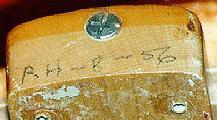
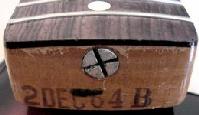
The body and neck dates on a 1956/1957 strat. The body date
(right) is in the middle pickup cavity on this guitar.

The body date on a 7/57 Telecaster, under the lead
pickup. The body date on the Telecaster moved from
the neck pocket to under the lead pickup around 1954
or 1955. Consistently by 1956 it usually appears
under the lead pickup.
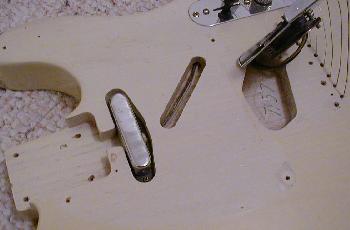
-
Fender Body Dates, 1950 to present.
- 1950 to 1954: Penciled by hand below the truss rod adjustment at the butt end of the neck usually in M-D-YY format. Many times the initials of the woodworker were also indicated, such as "TAD" or "TG" for Tadeo Gomez.
- 1954 to 1959: Penciled by hand below the truss rod adjustment at the butt end of the neck in M-YY format.
- Early 1959: Due to a complaint by a Fender customer as to an obscentity written on the neck butt, no markings were used for the first part of 1959. I've seen dates of 6-59, so they started using them again at least by mid-year.
- Mid-1959 to March 1962: Penciled by hand below the truss rod adjustment at the butt end of the neck in M-YY format.
- March 1962 to 1965: Ink stamp in dark blue or red ink below the truss rod adjustment at the butt end of the neck in "XX MMM-YY W" format. The "XX" is not the day of stamping. Instead it is a code for the type of neck (for example, "02"=Stratocaster, "3/4"=3/4 scale Musicmaster). The "W" is the neck width where "A" is the narrowest, "B" is normal, and "C" is the widest.
- 1966: the model number (the number stamped on the neck before the month) change (for example, "13"=Stratocaster).
- 1969: new type of neck stamp consisting of 6, 7 or 8 digits was used on some models. This new stamp was usually green ink. An example of this type of neck code is "529129B". The new green stamp was used concurrently with the previous "XX MMM-YY W" format. So a neck could have either code system! The model numbers change yet again (for example, "22"=Stratocaster). See below for more info.
- 1972: Fender changed to yet another new type of neck stamp which had 8-digits. This was stamped in green or red ink. A example of this is "02033923" found on a Jazz Bass. From 1972 through about March 1973, this new system was used concurrently with the previous "XX MMM-YY W" format. Again, a neck was stamped with either the new or the old date stamp, but not both. The model numbers change yet again (for example, "09"=Stratocaster). See below for more info.
- April 1973 to 1980: After March 1973, Fender dropped the old style date stamp and continued to use the new style, 8-digit code. See below for more info.
- 1976 to present: All non-vintage reissue instruments have the serial number printed in the decal on the face of the peghead. The approximate year of manufacturer can be determined from this (see serial number section below). Sometimes a date is also stamped or pencil written on the butt of the neck. Vintage reissue instruments have the date on the butt end of the neck as was used during the time period being reissued.
- 1980: Small adhesive labels with Month-Day-Year date stamps appeared in the neck pocket, pickup cavity and/or back of the neck.
- 1 = Jaguar 1962-1965
- 2 = Stratocaster 1962-1965
- 3 = Telecaster
- 4 = Jazzmaster 1962-1965
- 5 = Precision Bass
- 6 = Bass VI
- 7 = Jazz Bass
- 8 = Musicmaster II, Mustang, Duo-Sonic II 1964-1965 22 fret 24" scale model
- 9 = Musicmaster II, Mustang, Duo-Sonic II 1964-1966 21 fret 22 1/4" scale Model. Also found on 1969 Swinger "Arrow/Musiclander" models.
- 10 = Coronado 1 and 2, and some 1966 Jazzmaster and Stratocaster necks
- 11 = Bass V
- 12 = Electric 12 and Maverick/Custom model
- 13 = Stratocaster 1966-1968, many 1966 Jazzmasters too
- 14 = Coronado 12
- 15 = Jaguar 1966-1972
- 16 = Musicmaster II, Mustang, Duo sonic II, and Bronco
- 17 = Mustang Bass and MusicMaster Bass
- 18 = Coronado Bass
- 19 = Jazzmaster and Coronado 2
- 22 = Stratocaster 1968-1972
- 23 = Telecaster Bass
- 27 = Villiager 12
- 28 = Shenandoah 12
- 5 = code for Precision Bass
- 291 = batch or lot code
- 2 = February
- 9 = 1969
- B = 1 5/8 inch neck width (correct for a �69 P-Bass).
- 22 = code for Stratocaster
- 384 = batch or lot code
- 10 = October
- 9 = 1969
- B = 1 5/8 inch neck width
- 49 = model code (Musicmaster, Mustang, Bronco)
- 00 = neck code (rosewood fingerboard)
- 21 = week code (week 21)
- 5 = year code (1975)
- 3 = day of the week code (Wednesday)
- 01 = Precision Bass
- 02 = Jazz Bass
- 04 = Mustang Bass
- 08 = Telecaster Deluxe
- 09 = Stratocaster
- 13 = Telecaster, Telecaster Custom, Telecaster Thinline
- 49 = Musicmaster, Mustang, Bronco
- 00 = rosewood fingerboard
- 01 = rosewood fingerboard
- 03 = fretted maple neck OR skunk stripe neck with rosewood board
- 10 = fretless maple neck
- 01 = Precision Bass
- 03 = fretted maple neck
- 10 = Week 10
- 5 = 1975
- 1 = Monday
- 13 = Telecaster
- 03 = rosewood fingerboard on skunk stripe neck
- 16 = Week 16
- 7 = 1977
- ? = day unknown as digit was illegible
- Telecaster/Esquire: consistent peghead shape from 1950 (Broadcaster) to present, except on the "Telecaster Deluxe".
- Stratocaster: "small" peghead shape from 1954 to end of 1965. At the very end of 1965 Fender enlarged the peghead shape. This "big head" size was used till 1980.
- In 1980 Fender changed back to the small Strat-style peghead design on most models (except the Tele).
- Telecaster/Esquire: thin "spaghetti" logo (silver with black trim, except for 1952 to 1955 Esquires which were gold with black trim) from 1950 (Broadcaster) to late 1965. Larger "transition" logo used from late 1965 till 1967. Thick "black" logo was used from 1968 to 1980. The Tele Custom and Esquire used the "spaghetti" logo from mid-1959 to late 1960's (stock not depleted till later).
- Stratocaster: thin "spaghetti" logo from 1954 to fall 1964. Larger gold "transition" logo from fall 1964 till 1967. Thick "black" logo from 1968 to 1980.
- Pbass, Jazzmaster: followed same trend as the Stratocaster.
- Jazzbass: from 1960 to 1967 the Jazzbass always used a "transistion" style logo. Switched to the thick "black" logo in 1968. Note Jbass never used a "spaghetti" style logo.
- In the 1980's Fender changed back to using "transition" and "spaghetti" logos, depending on the model.
- Exceptions: during the 1960s if any particular model (be it a Strat, Jaguar, Jazzmaster, Jazz Bass, etc.) was an original *black* custom color with a matching black peghead, a different peghead decal was used. Why? Because the normal decals don't show up when applied over black. So black pegheads during the 1960s will usually have just a "Fender" logo, without the model name (and in a different font style). Also the "contour body" decal will be missing.
- Strat, 1954 to 1966.
- Strat spaghetti decal repro vs. original
- Strat transition decal repro vs. original
- Esquire, 1950 to 1968.
- Custom Esquire, 1959 to 1968.
- Custom Telecaster, 1959 to 1968.
- Jaguar, 1962 to 1974.
- Jazzmaster, 1962 to 1975.
- Precision Bass, 1951 to 1968.
- Jazz Bass, 1962 to 1967.
- Telecaster Bass, 1968.
- Bass 6, 1961 to 1968.
The earliest models (Broadcaster, NoCaster, Telecaster) had a body date under the neck, in the neck pocket. But by 1954 or 1955, this date moved to under the lead pickup (but didn't show up consistently in this spot until 1956). Stratocasters also had variable body date positions. Usually they are seen in the rear tremolo cavity (if the Strat is a tremolo model!). But it is also common for the body date to be under the middle pickup. For all models, by about 1963 or 1964, body dates were rarely used.
Fender Neck Dates, 1950 to present.
From the first solidbody guitars to 1976, Fender dated their instruments at
the "butt" of the detachable neck. Here is a timeline of the format the
dates, and how they were printed:
1962 to 1968 (mostly) Neck Stamp/Model designations.
Starting about April 1962, Fender went from a hand written neck butt date
to stamped date. Usually the date had a code (often mistaked as a day of the
month/year) preceeding the date, to signify what model the neck belongs.
Note in 1966 many model numbers changed.
Here is a list of those codes and the years that they were used.
1969 to 1980 Neck Stamps.
This information was documented and written by Greg Gagliano, and was published
in a 1998 article in 20th Century Guitar magazine.
About 150 Fenders made between 1967 and 1980 were examined. Of these, less than half had useable information. In most cases, the stamp was smudged beyond legibility or the stamps were incomplete. Many guitars had no stamped codes at all. Some guitars simply had the model name, such as "MUSTANG" stamped on the butt end of the neck in green or red ink.
This means two things for the owner of a 1969 to 1980 Fender. First, the chances of having an intact stamped code is about 50/50. Second, the dataset for making conclusions is relatively small and therefore, subject to change as new information surfaces. However, the interpretation of the two date code systems appears to be relatively straight forward and the conclusions were confirmed by pickup dates and pot dates in most cases.
-
The 1969 to 1971 Neck Stamps Explained.
This information was provided by Greg Gagliano. The neck stamp used from 1969 to 1971 can be extracted by working from the outside inward. For example, let�s take Telecaster Thinline (s/n 272207) with the code: 3320119B. Starting a the right we have the letter B. This appears to be the same neck width code that Fender had been using since 1962. The next digit denotes the year, in this case 9 = 1969. The next one or two digits denote the month, in this case 11 = November. The first one or two digits of the code, in this case 3, denotes the model. For Telecasters, Telecaster Thinlines, and Esquires that code is 3. For Stratocasters it is 22 and for Precision Basses it is 5. The other three digits (320) are perhaps some kind of batch or lot number. It could also be the number of instruments of this type produced for that month, but I would suspect Fender could make more than 999 of any one instrument type in a month. Hence it is probably a batch or lot number.
Here�s our P-Bass again (s/n 277983) with the code 529129B. Breaking up the code we get:
Here's another, a Strat (s/n 279515) with code 22384109B. Break it into pieces:
Exceptions do exist. A few Telecasters have shown up with neck codes that would indicate a 1967 date and one has been reported with a possible 1968 date, yet the rest of the guitar appears to be from 1969. If Fender used the coding system as early as 1967, then we should see more 1967 and 1968 guitars surfacing with the green stamped code. One explanation is the use of leftover necks. Fender is known to have done this often. Other exceptions exist too. For example, a 1970 Strat with the neck code 2231008B. The first "22" is the model (Strat), and the ending "B" is the neck width. But the "008" is not the month and year. I can't really explain why this happens, but it does on the occassional Fender guitar from this era.
1972 to 1980 Neck Stamps Explained.
This information was provided by Greg Gagliano.
The 1972-1980 eight digit code is similar to the previous 1969-1971 system.
Example, Music Master (s/n 595121) with code 49002153.
The first 6 digits are paired off and the
last two digits are taken singly. So that gives us 49 00 215 3 where:
-
Model Codes Used from 1972 to 1980.
Model codes (first pair of digits):
Neck Codes Used from 1972 to 1980.
Neck codes (second pair of digits):
Here's a Telecaster (s/n S725092) with rosewood fingerboard and code 1303167?.
Differences between the end of a Telecaster and
Stratocaster neck. Note the Tele neck on the left
has a straight end, and the Strat neck on the right
has a rounded end. The bodies and pickguards are
cut differently to accomodate this.
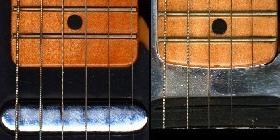
Style of Strat pegheads and logos from 1954 to 1980.
Shown is the "spaghetti" logo, the "transition" logo,
and the "black" logo on a large peghead. The Large
peghead style started in late 1965 on the Strat, and
lasted throughout the 1970s.
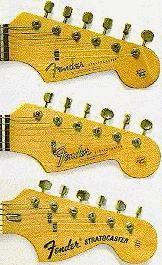
Peghead Shapes
Top: the "transistion" logo as
used on a Custom Telecaster
starting about fall 1964.
Bottom: the "spaghetti" logo as
used on a Custom Telecaster
in 1959.
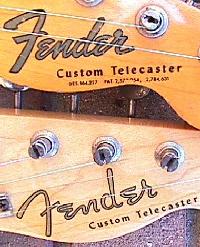
-
Peghead Decals
Peghead Decal Pictures.
The following are scans of most Fender decals used from 1950 to the late
1960s. These are all original, unapplied decals. Note decals from the
1970s are "backwards" (reversed). For comparison, I have "unreversed"
the pictures so the text is not backwards. Picture from Jim Shine.
Typical wear on a 1950's
Fender maple fingerboard.

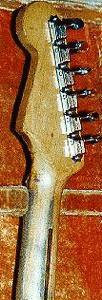
-
Fingerboard Material
- Maple fingerboard, 1950s: from the start in 1950, Fender used a one piece maple neck with a walnut "skunk" stripe down the back (except on early Esquires with no truss rod), where the truss rod was installed. This was the standard neck on all models until 1958 (when the Jazzmaster was introduced with a rosewood fingerboard; the rest of the Fender models changed to rosewood fingerboards in mid-1959).
- Rosewood fingerboard, "Slab" (Brazilian), 1958 to 1962: from mid-1959 (1958 for the Jazzmaster) till August 1962, Fender used a "slab" rosewood fingerboard. That is, the bottom of the fingerboard was flat and the board was fairly thick. A picture of a slab board neck (as seen from the "butt" of the neck) can be seen in this picture. Also shown is the difference between reissue and original slab board necks. The Musicmaster family also used slab fingerboards (usually Indian rosewood) for about a year from Sept 1965 to Oct 1966. Slab fingerboards are also identifiable from the peghead by their "hump" line (humps toward the tuners), just above the nut.
- Rosewood fingerboard, "Veneer", 1962-1980: from August 1962 till 1980, Fender used a curved bottom rosewood fingerboard that was much thinner than the slab 'board. The veneer of rosewood got even thinner by mid 1963. Also by 1966 the rosewood changed from Brazilian to Indian rosewood. Veneer fingerboards are also identifiable from the peghead by their "dished" line (dishes toward the nut), just above the nut.
- Maple fingerboards, 1960-1968: available as special order. Different than the 1950s one-piece maple necks. These used an actual slab maple fingerboard glued to the maple neck, and no "skunk stripe" down the back of the neck for the truss rod.
- Maple fingerboards, 1969 and later: Fender's maple neck changed back to the 1950s style one piece neck with a walnut "skunk stripe" down the back.
- Rosewood Fingerboards, 1980 and later: Starting in 1980, Fender switched back to the slab rosewood fingerboard style, made from Indian rosewood (except on certain recent custom shop models).
-
Fingerboard Dots
- Black dots: used on maple fingerboards and made of fiberboard-like material (in the 1950's) or black plastic later.
- White dots: used on rosewood fingerboards (Jazzmaster in 1958, all other models in mid-1959). Till the end of 1964 Fender used "clay" dots as position markers. This material has an off-white opaque color. In very late 1964 all models changed to pearl dot position markers. Side markers remained "clay" until spring 1965 when these too changed to pearl.
- White dot spacing: In 1963, the spacing of the two fingerboard dots at fret twelve changed (the spacing became closer together).
- 1950 to 1955: Fender neck shapes (all models) have a standard large and chunky "D" profile (big "baseball bat" style neck).
- 1956: Fender necks change to a large and chunky "soft V" profile.
- 1957: the "V" shape gets much stronger. This 1957 "strong V" neck profile becomes famous, and musicians like Eric Clapton prefer its shape. Some Fender necks produced have a "small strong V", where the neck isn't so big feeling, but still has a very strong "V" shape (mostly seen on Musicmasters and Duosonics, and the occassional Strat).
- 1958: the neck profile completely changes, with the "V" shape completely gone. It's back to a conventional "D" neck profile, but not nearly as thick and large as 1955 and prior neck profiles. This neck style is used on most reissue Fenders (regardless of the year being copied).
- 1959 and later: the "D" profile gets yet a bit smaller and less chunky. With the release of rosewood fingerboards on all models in mid-1959, the "D" neck profiles pretty much stay the same throughout the 1960s with only minor variance from year to year (for example, 1962 necks seem to be a bit chunkier than 1959 to 1961 necks).
- A = 1 1/2" wide at the nut.
- B = 1 5/8" wide at the nut (normal size).
- C = 1 3/4" wide at the nut.
- D = 1 7/8" wide at the nut.
- 4 bolt neck plates: all models used 4 bolt neck plates from 1950 to early 1971.
- 3 bolt neck plates: starting in early 1971, the Stratocaster, Telecaster Thinline, Custom Telecaster, Telecaster Bass used 3 bolt neck plate (the Telecaster and Precision Bass always used 4 bolt neck plates). In 1972 the Telecaster Deluxe (from introduction) also used the 3 bolt neck plate. By late 1972/early 1973, the Jazz Bass went to a 3 bolt neck plate.
- In 1979 the 4 bolt neck plate came back to the Anniversary strat. By 1980 all Stratocaster models were again 4 bolt. And by 1981, all Fender models converted back to the 4 bolt neck plate.
- 1950 to Mid-1956: Single round "button" string guide for E & B strings.
- Mid 1956: Changed to a "butterfly" string guide.
- 1959: a metal spacer is used beneath the butterfly string guide.
- 1964: the metal spacer is changed to a nylon spacer beneath the butterfly string guide during 1964.
- 1971: two butterfly clips are used for the E, B, G, & D strings on the Stratocaster, Telecaster, Telecaster Deluxe, Custom Telecaster.
- 1976: two butterfly clips on the Mustang.
- Click here to see the difference between reissue and original Fender "butterfly" string trees.
- October 1950: all Fender guitars have a truss. Only pre-October 1950 Esquires have no truss rod. Adjusts at the "butt" of the neck by the pickups. Click here to see the difference between vintage and repro Fender truss rod nuts.
- Late 1971: truss rod changed to adjust at the peghead behind the nut with a "bullet" system on Stratocasters and Jazz Basses. Telecaster and Precision Bass keep traditional truss rod system.
- 1980: Fender starts using different truss rod systems, depending on the model.
Neck Back Shapes (profiles), all guitar and bass models.
Fender neck shapes have changed through the years too.
Neck Width.
From March 1962 to 1969, Fender marked their necks with an "official"
neck width letter at the butt of the neck (in front of the date code).
The "B" neck width is the normal width, as used on about 99% of all
Fenders from this period.
All other sizes were available by special order only.
Also all pre-1962 Fender necks have a 1 5/8"
nut width (though I'm sure there are some exceptions,
but none I have seen).
Neck Shims.
Shims were used between a Fender neck and body to adjust the "neck
set" of the instrument (the "neck set" is the angle of the neck in
relationship to the body; if the neck set is too shallow, it needs a
shim so the playing action can be lowered with the bridge to a comforable level.
If the neck set is too sharp, the strings can not be raised enough
with the bridge to stop string buzz). Fender adjusted the neck set at
the factory with a shim. Some Fenders use them, so don't. Click
here for a
picture of the shim used during the 1950s and 1960s.
Neck Bolt Numbers (3 or 4).
Peghead String Guides (or "String Tree").
String guides were used on most models to give the treble strings
greater string tension across the nut.
Truss Rod and Truss Rod Nut
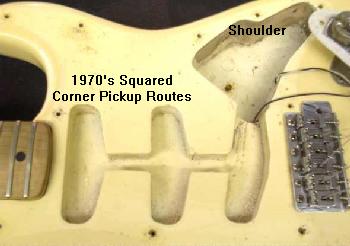
The body routes on a 1968 Stratocaster. Note the rounded
pickup route corners, compared to the 1970's pickup routes
seen above.
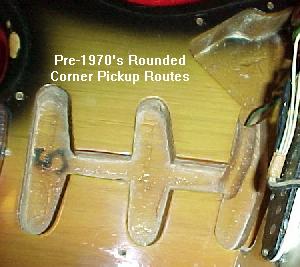
The body routes on Telecasters. In the 1970's the
"notch" was removed from the bass side of the neck pocket.
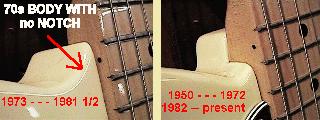
-
Body Routes.
Initially, when the Fender Stratocaster was introduced in 1954, it had a single layer white pickguard attached with 8 screws. In mid 1959, Fender switches to a multiple layer pickguard with 11 mounting screws. One of the additional screws required a change to the interior body route on the Stratocaster. Now a added "shoulder" was left in the electronic route to accomodate one of the extra pickguard screws. Starting in the late 1960's, Fender also changed the shape of the pickup routes on the Strat. Now the corners were more square, instead of being round.
The Telecaster body also changed in the 1970's. The "notch" that existed on the bass side of the neck pocket was removed. See the picture above.
1956 to 1964 style single line
Kluson tuners on a Tele neck.
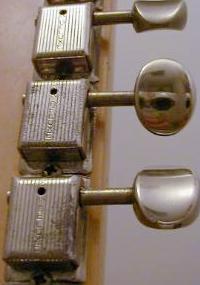
-
Tuners
- 1950-late 1951: Fender used "single line" Kluson tuners, that had "Kluson Deluxe" stamped in a single vertical row (like 1956 and later Klusons); these are easily identified as "early" Klusons (and not 1956 and later Klusons) because "PAT APPLD" is also stamped below the vertical "Deluxe" marking. These are also different because they lack the side worm shaft hole for the tuner shaft (there is only a side "entrance" hole).
- 1952 to 1953: Fender used "no line" Kluson tuners exclusively, and were unmarked (had no brand name stamped in the tuner back). The "PAT APPLD" is no longer there. Also still no side worm shaft hole for the tuner shaft.
- 1953 to mid-1956: There is now a side tuner shaft worm gear hole. Still "no line" style casing (had no brand name stamped in the tuner back).
- Mid-1956 to 1958: "Kluson Deluxe" is now stamped in the outside tuner casing in a single vertical line. The bottom side of the tuner is still stamped "PAT APPLD" (only seen if tuner is removed from peghead). Fender used Kluson tuners exclusively on all models. The only variable was the tuner tip. DuoSonics, MusicMasters, Mustangs and other low-end models had white plastic tips, all other models had metal tips.
- 1958 to 1964: "Kluson Deluxe" still stamped in the outside tuner casing in a single vertical line. But the bottom side of the tuner is stamped "PAT NUMBER" (as Kluson was granted a patent, and the patent "D" number is only seen if the tuner is removed from the peghead).
- 1964 to 1967: Fender used Kluson tuners, but now the "Kluson Deluxe" was stamped into two vertical lines ("Kluson" in one line, "Deluxe" in the other). Note some models (such as the Jazzmaster and Jaquar) the use of Kluson tuners ended in mid 1966 (see below).
- Fall 1965 to late 1970's: Fender had tuners made for them with a big "F" stamped in the back cover. Tuner buttons were chrome plated plastic. Note models such as the Jazzmaster and Jaquar (1966) and the Musicmaster family (fall 1965) got these tuners before Strats and Teles (late 1967/1968).
- Click here to see the different Fender tuners used from 1952 to the 1970s.
- Click here to see a comparison of vintage versus reissue Kluson tuners.
- Click here to see a comparison of vintage versus reissue Kluson tuner bushings.
- 1950 to 1962: the tone capacitors are either big, round (sausage-like) paper caps on Teles and Esquires, or flat box-shaped paper caps on Stratocasters.
- 1963 to present: all models use a standard ceramic pancake-shaped tone capacitor.
- 1968: Seemingly for this year only, most Stratocasters have a green square "chicklet" style tone cap (this may include other models too).
Tone Capacitors
Old style (pre-1971) Stratocaster bridge. Note the nickel plated
saddles with "Fender Pat. Pend." stamped in them. Reissue saddles
look exactly the same but are stamped "Fender Fender". Also since
the pickguard is removed on this Strat, we can see the "nail hole"
just above the pickguard screw hole. If this nail hole does not
have paint in it (as seen here), the finish is probably original.
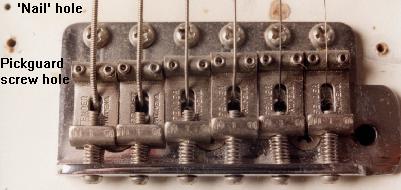
Old style Telecaster bridges. The bridge at the top
is a mid-1954 and prior style Tele bridge with brass
saddles, and the serial number stamped into the bridge
plate (reissue vintage Tele bridge plates with serial numbers have
a "dot" pressed below the third number in the serial number, so not to be confused with
original Tele bridge plates). The picture below it shows the low E/A string
saddle, and how it is ground flat on the bottom. The
picture at the bottom is a mid 1954 to 1958 style Tele bridge
with "smooth" saddles, and no serial number on the
bridge plate. In 1958 Fender then switched to
"threaded" saddles on the tele bridge (not shown).
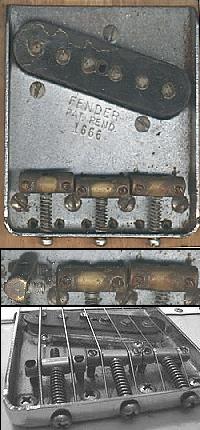
-
Strat Bridge Saddles and Tremolo Blocks
- Bridge Saddles 1954-1971: The Stratocaster used the same bridge saddle from 1954 to 1971, a piece of steal stamped into shape. These are stamped "FENDER PAT. PEND".
- Bridge Saddles 1971-1981:In 1971 the Strat bridge changes to a less expesive saddle made of cast metal.
- Reissue vintage Strat bridge saddles are also stamped metal. But these are stamped FENDER FENDER) on the saddle. Click here for a picture.
- Recent "bogus" Strat saddles are now available in which many individuals pass-off as originals. Click here for a picture.
- Strat Tremolo Blocks 1954-1971: a separate solid piece of gray painted steel. Click here for a picture.
- Strat Tremolo Blocks 1971-1981: case metal which is now part of the bridge plate.
- 1950 to March 1964: all models had "black bottom" pickups and cast slug alnico magnets with rounded top edges. Pickups not dated. Pickup wire is usually a real rich cooper color. Pickups are dipped in hot wax to eliminate microphonics, and this wax is evident on the entire pickup. Also the pickup screw "springs" are made out of rubber surgical tubing cut into small 3/8" long pieces.
- March 1964 to late 1970's: most models had "gray bottom" pickups and cast slug alnico magnets. Gray bottom pickups would be the rule, but black bottom pickups were used from old stock as late as 1967. Starting in the early 1970's, the top edges of the magnets were no longer rounded. Most gray bottom pickup assemblies have at least one pickup with a hand written date. By the late 1960's this changed to an inked stamped date code, much like the date code used on the butt of the neck. Most gray bottom pickups have a deep burgundy colored pickup wire. Wax treament is no longer used in favor of a lacquer dip treatment, which is much harder to see. Pickup screw springs are now actually real cone-shaped springs instead of rubber surgical tubing. Click here for a picture of gray bottom pickups (1970s). Click here for a picture of a November 4, 1964 gray bottom pickup date stamp.
- Fender used mostly Stackpole brand pots in the 1950's, and CTS brand pots in the 1960's. These pots are date coded, and can help verify the authenticity and year of an instrument. The manufacturer code for CTS is 137 (or 304 for Stackpole), so this number should be stamped on the pot somewhere. Following this number is the date code in YWW or YYWW format. The "Y" or "YY" is the last digit(s) of the year, and the WW is the week. In the 1950's, YWW date format was used. For example, "137504" would be a CTS pot made in the 4th week of 1950. A code of "1376344" would be a CTS pot made in the 44th week of 1963.
- The Telecaster, Esquire, Precision Bass, etc, because of their metal knob configuration, used "smooth solid shaft" pots. Guitars with plastic knobs (Stratocaster, Jazzmaster, etc.) used "knurled split shaft" pots. The split shaft pot could be adjusted for variable tension against the inside of its plastic knob, and the knurling stopped the plastic knob from slipping. The Telecaster or Precision bass type metal knobs with the small set screw (which was tightened against the pot's solid shaft to hold the knob) was better with a solid shaft pot. The only exception to this rule was early production 1954 Fender Stratocasters with the small plastic knobs (4/54 to about 7/54). These small "tallboy" plastic bakelit knobs were implemented on the Strat with solid shaft pots (perhaps Fender didn't have any split shaft pots in stock at the time, as the Strat was the first Fender guitar with plastic knobs).
- Note during 1966, CBS/Fender bought a huge supply of CTS pots. Because of this, many late 1960's Fenders have pots dated from 1966.
- Here is a picture of 1960s to 1974 CTS pots, compared to 1974 and later CTS pots. Click here.
- More info on pots can be found at in the Feature section, by clicking here.
Pickups and Pickup Springs
Potentiometers
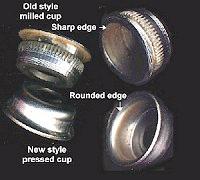
-
Wiring
- 1950 to 1967: all models used "cloth" wire where the shielding is actually made of cotton. Usually the color is black for ground and white for "hot". Starting in 1965 sometimes yellow is used instead of white. Jazzmasters and Jaquars also used other colors like red and blue.
- 1968 to early 1980's: PVC plastic shielded wire is used. Black for ground, white for "hot".
- 1980's: all reissue guitars use the old style cloth shielded wire.
An original 1956 Stratocaster wiring harness and pickguard.
Notice the small metal shielding plate around the pots,
and the white single layer pickguard. At the top edge is a
early 1960's three-layer celluliod "mint green" pickguard
with it's full-size aluminum shielding plate.
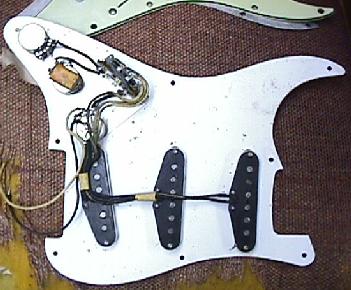
First generation CRL switches from 1950 to 1953 had two patent numbers.
Second generation CRL switch used from 1953 to about 1962 have three
patent numbers. Otherwise the two and three patent number switches look
identical. Shown below is a three patent number switch and brown
center wheel.
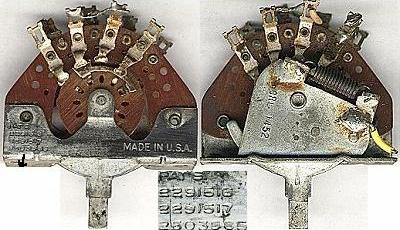
Top: 1963 to 1970s style CRL 3-way switch with round base.
Bottom: mid 1980s style 3-way switch.
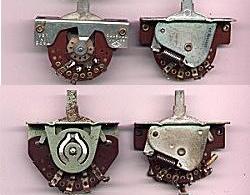
-
Telecaster/Stratocaster Switches
- 1950: On the first single pickup Esquires Fender used a different flat looking 3-way switch.
- 1950 to 1953: Early style CRL 1452 3-way switch with two patent numbers (2291516, 2291517). Switch made of metal and a fiberous brown bakelite type material holding the switch contact that has flat side cuts. This style of switch started with the 1950 double pickup Esquire.
- 1953 to 1962: CRL 1452 3-way switch with three patent numbers and the bakelite with flat side cuts.
- 1963 to 1965: Teles and Strats still use the CRL 1452 3-way switch, but the fiberous brown bakelite material that holds the switch contacts is replaced with a less fiberous brown bakelite (lighter in color) that is cut round (like a half moon, instead of having flat sides). The center wheel is still brown bakelite.
- 1965 to circa 1973: Teles and Strats still use the CRL 1452 3-way switch with the less fiberous brown bakelite round cut (half moon) center. But now the center wheel is white plastic instead of brown bakelite. May or may not have a Diamond logo (seen both ways).
- circa 1973 to early 1980s: CRL 1452 switches still look basically the same as the previous version, but only one patent number. Definately a Diamond logo during this period. These switches still say "Made in USA" but are actually only assembled in the USA (parts made in Japan).
- 1977 to present: Fender strats use a CRL 5-way switch on many models, which looks the same as the CRL 3-way switch but with two added notches in the switch lever metal.
- CRL 220-283: Special Heavy Duty switch replacements, flat-side type (pre-moon), used on some stock 1959-1960 Telecaster Customs for VIPs up to 1964. Fender bought 4000 of these in total, and just used them on special Teles and some Strats.
- CRL 220-288: confirmed as original "Special" switch replacement for Strats only (extremely scarce). Probably less than a handful were shipped to dealers when the supply of (4,000) CRL 220-283 switches had run out by mid-1964. The quote from Al Petty is, "if you have one of those switches in your Fender, you probably have an employee guitar or it was a guitar for someone special."
- Thanks to P.Bechtoldt for much of the CRL switch information.
A virgin 1960 Stratocaster pickup assembly with no broken solder joints,
"black bottom" pickups, "cloth" wire, flat box-shaped paper tone cap,
rubber pickup springs, flat edge 3-way switch, CTS pots, and an
aluminum pickguard shield all attached to a "green" pickguard.
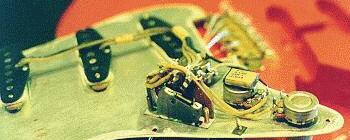
-
Pickguard Material
- Black pickguards: black pickguards were used from 1950 to mid-1954 on the Telecaster, Esquire and Precision bass. This material consisted of a fiberous bakelite, and was about .060 (inches) thick. The fiberous material was added to the bakelite to add strength (bakelite is too brittle and would crack at that thickness without it). Finally the black pickguards were clear-coated with clear nitrocellulose lacquer (top side only) to give them depth and shine.
- White pickguards (single layer): starting in mid-1954 on the Telecaster/Esquire and Precision bass, and from the start on Strats in 1954. Fender used a single layer white pickguard material made from ABS or vinyl about .060 (inches) thick. This relatively new material for the time was cheap, easy to work with, and somewhat flexible. Note bakelite was never used for white Fender pickguards on any model (though many people refer to white pickguards as such; but it's not bakelite). Fender stopped using the white material in mid-1959 except on the Telecaster, Esquire and DuoSonic/MusicMaster. In this case the single layer thickness increased to .080 (inches), and was used till about 1965 (Esquires till about 1967, when all old stock was depleted).
- Multi-layer pickguards: starting in mid-1959 Fender switched to a 3 layer pickguard (w/b/w) made from Celluloid on most models. The Pbass and Jazzmaster used a 4 layer pickguard of Tortoise/w/b/w (except on certain custom colors which used a 3 layer w/b/w pickguard). These celluloid 'guards had an outer white layer with a mint green/yellow tint, thus giving them the name "green 'guard". The amount of green/yellow depends on the abuse and UV the pickguard was subject to. To some degree the effect is not only caused by age and sun, but the "felting" of the black layer below the white layer. This material was used till January 1965 when Fender switched to vinyl or ABS for their multilayer pickguards (Celluloid was dangerous and very flamable, and shrunk with time causing cracks). Sometimes these pickguards are called "nitrate 'guards" because nitric acid is one of the key ingredients used to make celluloid. The 1965 and later white pickguards do yellow a bit with age. But even aged white 'guards look much different than the older "green" 'guards. In the late 1960s, white Stratocaster pickguards change slightly (not sure about other models). Though from the front they look identical to the 1965 to 1967 variety, the 1968/1969 white Strat pickguards had a bottom layer (the layer not seen unless the pickguard is removed from the body) of "pearloid".
Left: the neck cavity on a custom color 1960 Strat. Notice the redish material the
factory used to angle the neck.
Right: the bottom side of this 1969 strat's pickguard uses "pearloid" material. This is
typical of 1968 and 1969 Strats.
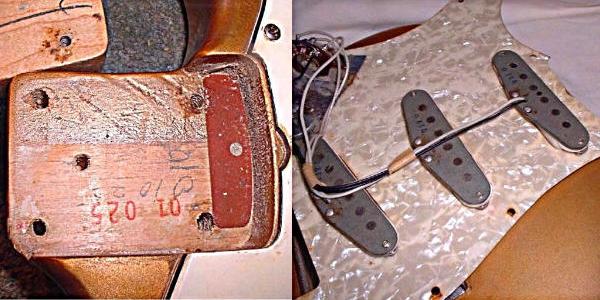
- Stratocaster pickguards: multi-layer Strat pickguards had a thin (.015") aluminum shield underneath the pickguard (see picture above) till 1967. Click here for a picture of the ink stamp on this aluminum pickguard shield used during the 1960s. From 1968 and later, sticky aluminum foil was attached to the bottom of the pickguard, just around the pots and switch. In the 1950's, this metal shield was much thicker (.040"), but also much smaller, only covering the area around the pots. Note reissue Strats also use these shields.
- Click here for a comparison of pickguard material used from 1962 to 1965, and a reissue pickguard.
Stratocaster Plastic Parts.
Left: The two pickup covers on the
outside are ABS plastic. The three covers on the insides
are "bakelite" (actually polystyrene, but collectors refer to it
incorrectly as "bakelite"). Note how the "bakelite" covers are whiter,
and the edges have rounded. When new, the "bakelite" cover
edges were as shape as the ABS covers. But with time,
the edges round only on the polystyrene covers. They can
even wear to show the black pickup itsef underneath.
Right: The top row of knobs are ABS, the bottom
row are "bakelite" (polystyrene). Notice again how the edges of the "bakelite"
knobs wear (especially on the volume knob), and the ABS edges don't. Also the "bakelite"
knobs are whiter.
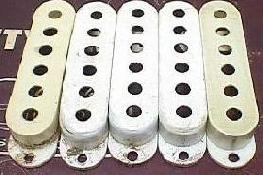
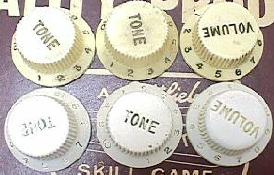
Telecaster Switch Tips.
The original Daka-Ware switch tips used on Broadcasters and
Telecasters from 1950 to the 1960s. These black bakelit tips
are made by Daka-Ware, with the earliest round tips only saying
"PAT. PEND." (as seen here on the left). The switch tip on the
right is a "top hat" style switch with a 2189845 patent number
(though round switch tips can also have these markings).
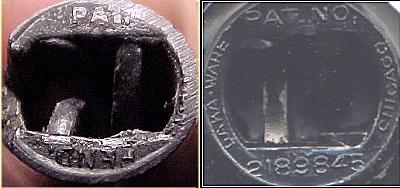
-
Other Plastic Parts (pickup covers, knobs).
- Stratocaster: this was the first Fender model to use plastic knobs and pickup covers. From 1954 to early 1957, these parts were made from white urea formaldehyde, commonly (and incorrectly) known as "bakelite" (bakelite is actually a trade name for phenol formaldehyde, and is most commonly black or molted brown; for consistency, I will refer to these white pickup covers as "bakelite", though in fact they are not). These covers were very brittle and very white. Note early 1954 Strat knobs have a different and taller shape than late 1954 and later knobs. Since "bakelite" cracked and wore very easily, Fender switched to white ABS parts in early 1957. These ABS parts yellowed with age unlike the earlier "bakelite" parts. Click here for a comparison of vintage versus 1980s and later Strat knobs.
- Telecaster/Esquire: these models didn't use plastic knobs or pickup covers. But the switch tip for Telecasters was bakelite plastic. These black tips are still available today, with very minor differences. Early Broadcasters/Telecasters had round (as viewed from the top) pickup selector tips. In about 1955 this changed to the "top hat" style of selector switch tip. In either case, all original Tele switch tips have some stampings on their bottom side. The Broadcaster and early Telecasters said "PAT. PEND." on the bottom of the tip. All tips about 1952 and later say "PAT. NO. 2189845" and "DAKA-WARE CHICAGO". See the picture above. Reissue "top hat" tele switch tips have no marks on the bottom. Click here to see the difference.
- Precision Bass: this model didn't use plastic parts till mid-1957 when the pickup changed to a split coil design, and had an ABS plastic cover. Click here for a comparison of old and new pbass plastic pickup covers.
- Jazzbass: click here for a comparison of old and new jbass plastic pickup covers.
- Jazzmaster: from the start in 1958 all plastic parts were ABS on this model. Click here for a picture of the knob style used on Jazzmasters starting in 1965.
- October 1950 to mid 1956: All models used Ash as the body wood. Most ash bodies are two or even three pieces, but sometimes a one-piece body was used.
- Mid 1956 to current: All models used Alder as the body wood. The ONLY exception to this is if the model had a "blond" finish. In that case, the body would was ALWAYS Ash. For example, since the stock finish on a Telecaster is "blond" (a translucent white color), all blond Telecasters are made of Ash. If a post-1956 Stratocaster was ordered in blond, it too would be Ash. To summarize, if the Fender instrument is later than mid-1956, and was originally not blond in color, the body wood should be Alder! Most alder bodies are 2 to 4 pieces. Alder trees do not grow "big", so multiple pieces were used for Fender guitar bodies. The number of pieces has little effect on sound or value.
- 1963-1964: a few models made with Mahogany bodies.
- 1990-current: Most Japanese Fenders (and some US made models) use a Basswood body.
- 1992-current: Some Mexican made models use Poplar bodies.
Body Wood.
Exceptions to the below data: the Rosewood Telecaster, the Walnut strat,
Thinline Telecasters, etc.
Left: a 1966 Custom Telecaster with the "target 'burst" style
sunburst. Starting in mid-1964, Fender sprayed the yellow part
of the sunburst. This allowed Fender to be less picky with their
choice of Alder, because the sunburst is less transparent.
Right: a 1959 Custom Telecaster with the old style Fender sunburst.
Prior to 1964, Fender stained the yellow of the sunburst into the
wood, instead of spraying it. This saved a spray step when shooting
a sunburst finish.
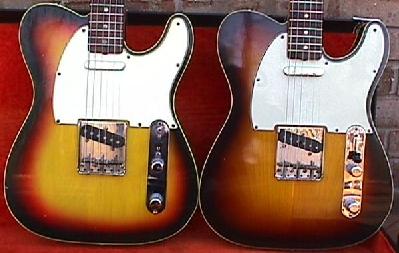
-
Finishes.
- 1950 to 1967: Fender used nitrocellulose lacquer for all finishes. Film thickness was very thin, especially in the 1950's. From the beginning, Fender would hammer nails into the face of the guitar body before painting, under the pickguard areas. Then the body was painted on a "lazy susan". First the face of the guitar was painted. Then the body was flipped over onto the nails (which suspended the freshed painted body face), and the back and sides of the body were painted. The nails were then used to suspend the body while the paint fully dried. After all the paint was sprayed, the nails were removed. Hence all original pre-CBS Fender bodies will have "nail holes" (with no paint in them!) under the pickguard or control plates.
- There should be three or four nail holes under the pickguard, control plate or bridge plate on every original finish solidbody pre-1965 Fender instrument. NO EXCEPTIONS! Interestingly, Tele nail holes were moved in the early 1960s, but are still present. Again, see here for more details.
There is a lot more info on Fender finishes here.
One nail hole near the neck pocket on a May 1962 Fender Stratocaster.
Note the "shadow" (lack of red) created by the nail, as the red was
originally sprayed on the body!
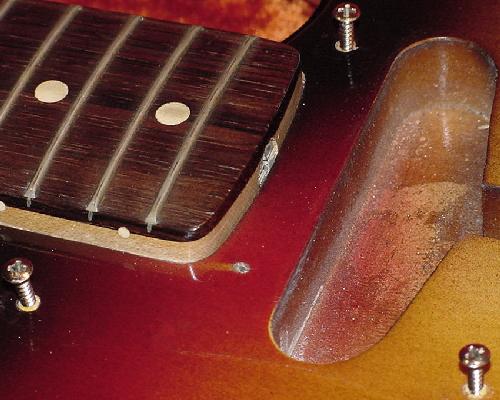
- Mid 1956: Fender started using Alder (instead of Ash) as the main body wood for all models that were not finished in Blond (which means the Telecaster stayed Ash). They did this because it was easier to paint Alder (it required less paint steps). All Alder bodies were dipped in a yellow stain, which was the first step in the sunbursting paint process (sunburst was Fender's primary color on Alder bodies, hence all Alder bodies were prepped this way, regardless of what color they were actually painted).
This Strat has a neck date of December 1964, and still has the "nail holes"
under the pickguard. The nails holes were pretty much gone by fall of 1964.
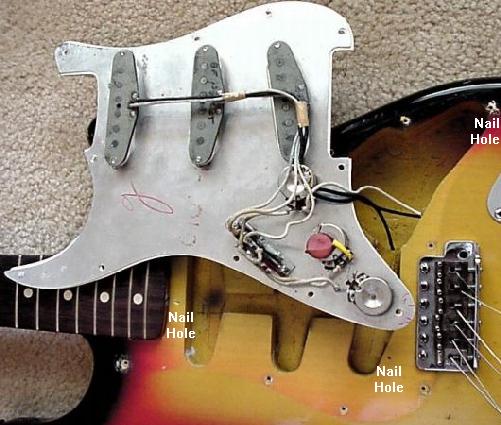
- 1960: The position of the nail holes was moved on the Telecaster (only). Then were now inside the cavity routes, like in the truss rod rod or neck pocket route, inside the control cavity route, and inside the bridge pickup route.
- Late 1962/early 1963: Fender now bolted a "stick" inside the body's neck pocket (to the two bass side neck screw holes) prior to painting. The stick allowed the body to be easily held by the painter while spraying paint and drying. This left a visible paint stick shadow inside the neck pocket. Fender used this technique into the 1970s. The nails were still used, but now only for the drying process (and were no longer needed during painting). Still, the "nail holes" will be present (with no paint in them!) under the pickguard or control plates of original Fender bodies.
- Mid-1964: Fender changed how they sprayed a sunburst finish. In early 1964 and before, the yellow part of the sunburst was stained into the wood. This meant Fender only had to spray two colors (red and brown) instead of three. But in mid-1964, Fender changed to spraying the yellow portion of the sunburst finish. This made the finish less transparent, and allowed Fender to use Alder body wood with minor defects (such as mineral stains). The 1964 and later sunburst finish colors didn't blend together as nice and don't show much wood grain, and hence are sometimes called a "target 'burst". Also by the fall of 1964, Fender no longer hammered nails into the body prior to painting. They instead used the paint stick to suspend the body while drying.
- 1968 to 1980: Fender used a "thick skin" polyester finish. Later "thick skin" finishes got really thick in the 1970's, resembling a bowling ball. But all polyester finishes are very thick and glossy compared to the early lacquer finishes.
- 1954 to late 1960's: Fender also made available Custom Color finishes. These finishes were special ordered for an additional 5% cost.
A 1962 Jaquar in the rare, top-of-the line molded form-fit case.
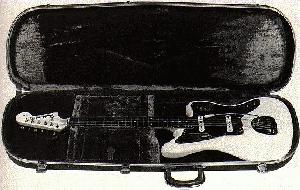
-
Fender Cases
Note that the following case descriptions concerns mostly U.S. sold guitars. Fenders distributed in other countries were often shipped without cases. The reason: the foreign distributor felt they could get cases locally and less expensively. Canada and Europe are perfect examples of this. Until the mid 1960's, most Canadian imported Fenders were sold with a Canadian case.
Note: the following info does not apply to student model Fenders such as the MusicMaster and DuoSonic. The interior material of these cases generally will match the descriptions below, but the exteriors will not. The exterior of these cases in the 1950's didn't have any material on them (they were just a brown formica), and didn't have any interior pocket system.
expensive rectangle hard shell tweed case.
Right Pic: Left to right: Tweed, brown tolex, white tolex.
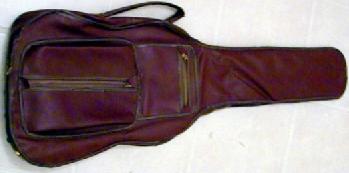
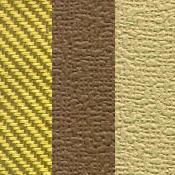
- From 1950 to 1953 Fender used a guitar-shaped hard case for the Tele and Pbass nicknamed the "thermometer" case, due to it's unique thermometer shape. This case had a brown covering with a brown plush lining. The case had a bulb shape at the peghead.
- Also available from 1951 to the early 1960's, was a Fender gig bag case. These cases are soft, foldable bags, and are brown in color. If you couldn't afford a hard case, this was the alternative.
- From mid-1953 to mid-1954, this case changed to the "poodle" case. Still shaped
like a guitar, the poodle case had one flat side that did not follow the
contours of the guitar (this was the side of the case that rested on the
ground when the case was set down by the handle). Though this case looks
similar for both the Telecaster and Stratocaster, it was not (a Strat won't
fit into a Tele poodle case). The interior was a bright red plush shag.
Click here
for a picture of the early "thermometer" and "poodle" style Telecaster
cases.
here
for a picture of the early "thermometer" and "poodle" style Telecaster
cases.
- In mid-1954, Fender dropped the guitar shaped case in favor of a rectangle shaped case. The first generation rectangle case used in 1954 was called the "center pocket tweed" case. The interior center pocket not only allowed cord and pick storage, but also supported the neck of the guitar. These cases were covered in lacquer-coated tweed and had a bright red plush shag lining.
- From 1955 to early 1958, the next generation of rectangle case
was the "side pocket tweed" case. The same lacquer-coated tweed outside
and bright red shag plush lining was used, but the interior pick pocket was
moved to the side next to the neck. They also had an interior tag
proclaiming the case as a "Koylon" brand case.
 These cases also had
exterior brown leather ends. In 1957 (only), these cases also had an exterior "Fender"
logo thick foil sticker which fell off 99.99% of all surviving cases today.
These cases also had
exterior brown leather ends. In 1957 (only), these cases also had an exterior "Fender"
logo thick foil sticker which fell off 99.99% of all surviving cases today.
- From 1958 to mid-1959, the case stayed the same except now the interior was a much shorter burnt orange plush. Also the "Koylon" interior tag is gone. The exterior thick foil sticker is now no longer used.
- From mid-1959 to 1961 the exterior of the Fender case changed. A new
material called "Tolex" was now used, in a coffee-with-cream type brown
color. Tolex is a rough rubber-like compound that was much more durable
than tweed. Brown leather ends stayed the same. The interior burnt-orange
plush used from 1958 stayed until about 1961 when the interior of the cases
changed to a dark orange plush. Also around 1960 the center manual latch
changed positions from under the case handle, to just outside of the case
handle (the latch's postion could hurt your knuckles when carrying the case.)
Click
 here
for a picture of the early square style Fender cases from mid 1954 to 1963.
This picture includes the "center pocket" tweed case, the "side pocket
Koylon" tweed case, the "side pocket burnt orange" tweed case, and the
1962 style "brown" case with the dark orange interior. The only case
missing from this photo is the 1959 to 1961 style "brown" case with
the lighter colored burnt orange interior.
here
for a picture of the early square style Fender cases from mid 1954 to 1963.
This picture includes the "center pocket" tweed case, the "side pocket
Koylon" tweed case, the "side pocket burnt orange" tweed case, and the
1962 style "brown" case with the dark orange interior. The only case
missing from this photo is the 1959 to 1961 style "brown" case with
the lighter colored burnt orange interior.
- In 1963 to early 1964, the exterior again changed on Fender cases. Now white tolex with black leather ends was the standard. The interior stayed the same dark orange plush.
- In early 1964, Fender moved to a black tolex case with the (same) dark orange interior. This type of case was basically used till the end of the 1970's, with some minor changes (mostly the exterior logo). Early 1964 to 1965 cases have no exterior "Fender" logo.
- mid to late 1965 to the 1970s use the same black case but with a Fender logo. This logo had two black plastic rivets holding the logo to the case exterior. There was no "tail" under the "Fender" logo.
- About 1967: Still used the black tolex case, but now the case exterior has a plastic Fender logo with a "tail" under the "Fender".
- about 1972: The logo on the black tolex case changes to have no "tail" and a small "R". Also the white piping around the leather case ends becomes more pronouced.
- Mid to late 1970s: The logo on the black tolex case changed yet again. No "tail", a bigger "R" (registered) mark, and a "Made in USA" marking. Also the interior of the case got more padding.
- When Fender started making reissues in 1983, they also reissued the tweed case. But now the exterior tweed was considerably "hairer", and was not lacquered. Also the interior was not a short dark orange plush, but was now a long, light colored orange shag.
- Also available starting around 1965 to about 1968 was a
brown molded form-fit case. This was an upper line optional case with a hard
brown molded exterior with a red/golden brown interior.
This case was basically rectangle, but with very rounded corners.
This case looks similar to the black molded Fender cases of the 1980's,
except this case is brown, thicker, a little shorter in length, and the
interior is not blue. This case was primarily available for the Jazzmaster
and Jaguar guitars.
The exterior case logos used through the years. The top
logo was used on rectangle Fender tweed cases from about 1957 to
early 1958. It is missing on 99% of all original tweed cases today.
No case logos were used from 1958 to 1965.
The next four plastic case logos were used from
1966 to the 1970s: 1966 Fender logo with no tail.
Thrid logo from top used in 1967 to 1971 ("tail"). Fourth
logo from the top with no tail and small "R" above the big "r" was used from 1972.
The bottom most plastic logo
(with "Made in U.S.A." and the "R" symbol) was adopted in the mid to late 1970's.
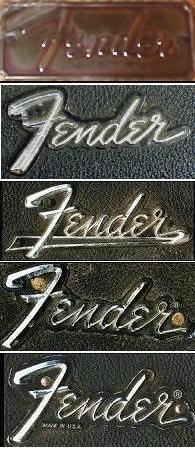
Fender Serial Numbers, 1950 to Present (Identifying the Year).
-
Serial numbers compiled from several sources including myself,
Gruhn, and Duchossoir. It should be clearly stated that Fender
serial numbers ARE NOT definitively chronological. That is, there's
lots of overlap between years. Basically there was a big bin of serial number
plates, and the installers grabbed one, and screwed
it to the guitar. They weren't managing the numbers in any way.
The point is, don't read too much into Fender serial numbers.
Pre-1977 Fender guitars have a serial number on the bridgeplate or neckplate. Serial numbers are basically chronological, but there is some overlap amoung years. Fender serial numbers were assigned like this: bin with serialized plates/bridges. Assembler reached in and grabbed one (or many). Put them on the instrument(s). As you can see from this over-simplified example, serial number assignment was fairly random. Just keep this in mind. The only truely definitive way to date a pre-CBS fender is to look at all the dates on the instrument (body date, neck date, pot dates). The serial number can only generalized the age of the instrument within a few years.
Esquires, Broadcasters, Telecasters 1950 to 1954 (number on bridgeplate). This system of serial numbers is unique to these three models until about the early summer of 1954 (when Fender switched to a universal neck plate serial number system for all models):
Telecaster, Numbers On Bridge Plate 0001 to 0999 = 1950 to 1952 1000 to 5300 = 1952 to 1954Precision Basses 1951 to 1955 (number on bridgeplate). Note there is some overlap. This system of serial numbers is unique to this model until about 1955 (even though Fender went to a universal neckplate serial number system on all instruments in 1954, some old style Precision Bass serialized bridges were still left over and used until 1955.)
Pbass, Numbers on Bridge Plate 100 to 400 = 1951 to 1952 0001 to 0999 = 1952 to 1954 1000 to 2000 = 1953 to 1955
Neck plates, clockwise from top left:
1954, 1956, 1972, 1960.
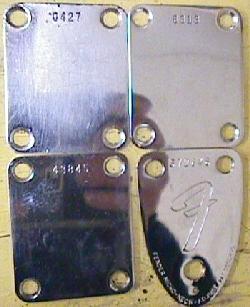
All Models, summer 1954 to mid 1976
Serial number on neckplate.
In 1957/1958 some serial numbers started with a minus sign ("-"), or
had a "0" prefix before the number. Also
in 1959/1960 some serial numbers were at the bottom of the neck plate
instead of the usual top. Double stamped serial number plates were also
produced (number on both front and back of the neck plate) in late 1957 to
early 1959. As a good example of all four of these serial number
oddities, click here.
This shows a "double stamped" neck plate, one number with a "-" prefix
and stamped on the bottom of the plate, and the other number with a "0" prefix!
And yes there is some overlap in serial numbers between years.
4 to 6 digit Neck Plate Serial Numbers
This style of neck plate started in 1954. No other letters or markings
on the neck plate, except for the rare "-" or "0" prefix, as noted.
Used on Telecaster, Stratocaster, Jazzmaster, Jaguar, Jazz Bass,
Precision bass, Duosonics, Musicmasters, etc. from 1954 and later.
Lots of overlap in numbers in adjacent years.
Don't read too much into these serial numbers,
it's not the best way to date a Fender guitar.
0001 to 8000 = 1954 6000 to 10000 = 1955 9000 to 16000 = 1956 16000 to 25000 = 1957 (some numbers with a "0" or "-" prefix) 25000 to 30000 = 1958 (some numbers with a "0" or "-" prefix) 30000 to 40000 = 1959 40000 to 58000 = 1960 55000 to 72000 = 1961 72000 to 93000 = 1962 93000 to 99999 = 1963L-Series (1963 to late 1965)
Serial number on neckplate preceded with an "L". Considered Pre-CBS (even though CBS bought Fender in January 1965). Sometimes an "L" serial number can be seen on a late 1962 model. Used on Telecaster, Stratocaster, Jazzmaster, Jaguar, Jazz Bass, Precision bass and other models. Lots of overlap in numbers from adjacent years. Don't read too much into these serial numbers, it's not the best way to date a Fender guitar.
L00001 to L20000 = 1963 L20000 to L55000 = 1964 L55000 to L99999 = 1965F-Series (late 1965 to mid-1976)
Big script "F" on neckplate below serial number. Known as the CBS era.
100000 to 110000 = late 1965 110000 to 200000 = 1966 180000 to 210000 = 1967 210000 to 250000 = 1968 250000 to 280000 = 1969 280000 to 300000 = 1970 300000 to 330000 = 1971 330000 to 370000 = 1972 370000 to 520000 = 1973 500000 to 580000 = 1974 580000 to 690000 = 1975 690000 to 750000 = 1976Serial Number on Peghead Decal.
U.S. made Fenders, starting in mid-1976 has the serial number on the peghead. Note the following number could be off as much as two years. Generally speaking, a "S" prefix equals the 1970's, "E" prefix equals the 1980's, and "N" prefix equals the 1990's. Note "E" and "N" prefix models are sometimes also Japanese-made (see below).
7600000 ("76" in bold) = 1976-1977
800000s = 1979-1981
1000000 to 8000000 = 1976-1981 (7 digits)
S1 to S5 + 5 Digits = 1979-1982
S6 + 5 digits = 1976
S7 + 5 digits = 1977-1978
S8 + 5 digits = 1977-1978
S9 + 5 digits = 1978-1981
E0 + 5 digits = 1979-1981
E1 + 5 digits = 1980-1981
E1 + 5 digits = 1982
E2 + 5 digits = 1982-1983
E3 + 5 digits = 1982-1984
E4 + 5 digits = 1984-1985, 1987-1988
E8 + 5 digits = 1988-1989
E9 + 5 digits = 1988-1990
In March 1985, CBS sold Fender to a group of private investors.The serial numbers do not reflect this change - Fender continued to make instruments using existing serial number schemes. The new Fender did not acquire any physical assets of the old company, just the name "Fender". Hence during 1985 to 1987, production of Fender guitars was only done in Japan, while USA Fender created a new factory in California. The Japanese-made Fenders do have some slight serial number differences (typically a "J" serial number prefix).
N9 + 5 digits = 1990 N0 + 5 digits = 1990-1991 N1 + 5 or 6 digits = 1991-1992 N2 + 5 or 6 digits = 1992-1993 N3 + 5 or 6 digits = 1993-1994 N4 + 5 or 6 digits = 1994-1995 N5 + 5 or 6 digits = 1995-1996 N6 + 5 or 6 digits = 1996-1997 N7 + 5 or 6 digits = 1997-1998 N8 + 5 or 6 digits = 1998-1999 N9 + 5 or 6 digits = 1999-2000 DZ0 or Z0 + 5/6 digits = 2000 DZ1 or Z1 + 5/6 digits = 2001 DZ2 or Z2 + 5/6 digits = 2002 DZ3 or Z3 + 5/6 digits = 2003 DZ4 or Z4 + 5/6 digits = 2004 DZ5 or Z5 + 5/6 digits = 2005Japanese Serial Numbers on Peghead Decal
Note the lack of S, E, N series. These are reserved for U.S. made Fenders in their corresponding decade. BUT note that the "E" and "N" series does sometimes appear on "made in Japan" models. I believe this was a mistake on Fender's part using the same prefix for both U.S. and Jap-made guitars. In any case, if it says "made in Japan", then it is...
JV + 5 Digits = 1982 to 1984 SQ + 5 Digits = 1983 to 1984 E + 6 Digits = 1984 to 1987 A + 6 Digits = 1985 to 1986 B + 6 Digits = 1985 to 1986 C + 6 Digits = 1985 to 1986 F + 6 Digits = 1986 to 1987 G + 6 Digits = 1987 to 1988 H + 6 Digits = 1988 to 1989 I + 6 Digits = 1989 to 1990 J + 6 Digits = 1989 to 1990 K + 6 Digits = 1990 to 1991 L + 6 Digits = 1991 to 1992 M + 6 Digits = 1992 to 1993 N + 6 Digits = 1993 to 1994 O + 6 Digits = 1994 to 1995 P + 6 Digits = 1995 to 1996Other Fender Serial Number Schemes.
Fender has recently (in the last 20 years) introduced LOTS of different serial numbers schemes, depending on the country the Fender was made (USA, Mexico, Japan, Korea, etc). Not all schemes are covered here! Sorry, since I do not collect new Fenders, I don't really keep track of these things. Below are some examples of letter prefixes used in recent serial number schemes.
V + 4 to 6 digits (U.S. Vintage Series) = 1982-1988 (neck date=exact year)
V + 5 to 6 digits (U.S. Vintage Series) = 1989-present (model dependant)
AMXN + 6 DIGITS = California Series electric guitars and basses, '97 and '98
DN + 6 DIGITS = American Deluxe series instruments, '98 and '99
NC(XXXXXX) = Squier Strat Bullets (dating unclear)
FN(XXXXXX) = US made guitars and basses destined for the export market.
Some may have stayed in the U.S or found their way back
(dating unclear)
I(XXXXXXX) = Limited number of these "I" series guitars were made in '89/'90.
They were made for the export market and have Made in USA
stamped on neck heel.
LE(XXXXXX) = Blonde Jazzmasters and Jaguars with Gold hardware made in 1994.
Sold as a promotional 3 piece set with a Blonde Deluxe Reverb Amp
CN(XXXXXX) = Korean made Fender/Squier guitars (dating unclear)
VN(XXXXXX) = Korean made Fender/Squier guitars (dating unclear)
CA(XXXXX) = Gold Strat 1981, 82 and 83
CB(XXXXX) = Precision Bass Special from 1981, CB(XXXXX) Gold Jazz Bass from 1982
CC(XXXXX) = Walnut Strat 1981-82-83
CE(XXXXX) = Precision Bass Special from 1981, Black and Gold Tele from 1981-82
CD(XXXXX) = Precision Bass Special (Walnut) from 1982
CO(XXXXX) = Precision Bass Special (Walnut) from 1982
GO(XXXXX) = Precision Bass Special (Walnut) from 1982, Gold Strat 1982-83
D(XXXXXX) = Jazz Bass from 1982
SE8(XXXXX) = Signature Edition Strats (dating unclear, check neck date)
SE9(XXXXX) = Signature Edition Strats (dating unclear, check neck date)
SN0(XXXXX) = Signature Edition Strats 1990
SN1(XXXXX) = Signature Edition Strats 1990
SN2(XXXXX) = Signature Edition Strats 1992
SN3(XXXXX) = Signature Edition Strats 1993
3 digits of 500 = 35th Anniversary Strat from 1989-1990
G(XXXXXX) = "STRAT" from about 1980, (Gold hardware, 2 pos. rotary tone switch)
4 digits stamped on bridge plate = 1952 reissue Telecaster 1982-1988
(Check neck date for exact year)
5 digits stamped on bridge plate = 1952 reissue Telecaster 1988-present
(Check neck date for exact year)
Fender Electric Model info
Fender Acoustic flat top Model info
Contact the vintage guitar info guy
Back to the Table of Contents
Copyright 1995-2002 all rights reserved.